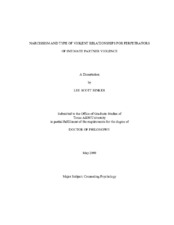| dc.description.abstract | The study proposed to distinguish differences in perpetrators of Intimate Partner
Violence (i.e., Common Couple Violence and Patriarchal Terrorism) due to the
mediating effect of their presentations of narcissism (covert and overt). Distinguishing
perpetrators of Intimate Partner Violence by their narcissistic presentations should assist
clinicians in batterer treatment programs to create specific lessons/interventions for
perpetrators of Intimate Partner Violence based on their narcissistic quality.
The study of a cross-section of men in a Batterer Intervention Program included
measures on self-perception, views of partner, and history of violent, aggressive,
controlling, and psychologically abusive interactions with their partner. Structural
Equation Modeling with Analysis of Moment Structures was used to determine the
structure and function of narcissism and interpersonal violence.
Intimate Partner Violence was distinguishable as Common Couple Violence or
Patriarchal Terrorism, but the results were not sufficiently conclusive to warrant an
absolute classification system. Overt Narcissism was somewhat useful in distinguishing Patriarchal Terrorism from Common Couple Violence by mediating the effects of
violent behaviors, controlling behaviors, and psychological abuse when mediated by
type of narcissism. That information is useful for clinicians interested in creating
targeted interventions to participants in Batterer Intervention Programs to reduce
Intimate Partner Violence and violent recidivism. Specifically, Common Couple
Violence was described by the number of times the participant physically injured the
partner over the past year, the total number of conflict tactics used, and whether their
partner needed medical attention following physical injury. Patriarchal Terrorism was
described by psychological abuse and controlling behaviors.
Overt Narcissism increased Patriarchal Terrorism, whereas, Covert Narcissism
did not assist in distinguishing Common Couple Violence from Patriarchal Terrorism.
The mediating effect that Covert Narcissism had on violent behaviors, controlling
behaviors, and psychological abuse was weak. Overt Narcissism is a more useful
construct when identifying potential Patriarchal Terrorists, while Covert Narcissism was
not found to provide additional detail to either Patriarchal Terrorism or Common
Couple Violence. Knowing the differing and similar impacts of those constructs can
potentially grant greater clinical effectiveness with perpetrators of Intimate Partner
Violence. | en |


